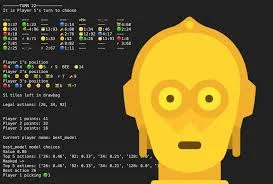Python's versatility extends beyond traditional programming tasks into the realm of game development, where it can be used to create simple yet engaging artificial intelligence (AI) games. This guide explores how to develop basic AI games using Python, covering key concepts, practical examples, and resources for beginners to start coding their own games.
Introduction to AI Games in Python
AI games refer to games where artificial intelligence is used to control aspects of gameplay, such as opponent behavior, game strategy, or character interactions. Python's ease of use and extensive libraries make it an excellent choice for developing these games, even for beginners with minimal programming experience.
Key Concepts of Simple AI Games
Game Development Basics: Understand the fundamentals of game development, including game loops, input handling, and rendering graphics using libraries like Pygame.
AI Algorithms: Explore basic AI algorithms suitable for games, such as decision-making (e.g., minimax algorithm for game playing), pathfinding (e.g., A* algorithm for navigation), and behavior trees for character AI.
Python Libraries: Utilize game development libraries like Pygame for graphics and input handling, as well as AI libraries such as simple ai or Pygame AI for implementing game AI logic.
Game Design: Learn principles of game design, including game mechanics, user interface (UI) design, and balancing gameplay elements to create an enjoyable player experience.
Getting Started with Simple AI Games in Python
To start building AI games in Python, follow these steps:
Install Python and Pygame: Download and install Python from python.org and install Pygame using pip (
pip install pygame) to get started with game development.Setup Development Environment: Choose an integrated development environment (IDE) like PyCharm or Visual Studio Code for coding Python projects efficiently.
Learn Python Basics: Familiarize yourself with Python programming basics such as variables, loops, functions, and object-oriented programming (OOP) concepts.
Explore Game Development: Start with simple game development tutorials using Pygame to create basic games like Pong, Snake, or Tetris to understand game mechanics and programming techniques.
Implement Basic AI: Integrate basic AI algorithms into your games, such as opponent behavior in a strategy game or enemy movement in a platformer using decision-making or pathfinding algorithms.
Practical Examples of Simple AI Games
Tic-Tac-Toe AI: Develop an AI player using the minimax algorithm to play against a human player in a terminal-based Tic-Tac-Toe game.
Snake Game AI: Implement an AI-controlled snake that autonomously navigates the game board to collect food and avoid collisions using pathfinding algorithms like A*.
Pong Game AI: Create an AI opponent for the classic Pong game that calculates the optimal position to intercept the ball and return it to the player.
Resources for Learning Simple AI Games in Python
Pygame Documentation: Explore Pygame's official documentation and tutorials for learning game development with Python and integrating AI features.
Online Courses: Platforms like Udemy and Coursera offer courses on game development and AI programming using Python.
Community Forums: Engage with Python and game development communities on Reddit (e.g., r/pygame), Stack Overflow, and GitHub to seek advice, share projects, and collaborate with other developers.
Conclusion
In conclusion, developing simple AI games using Python offers a hands-on approach to learning both programming and artificial intelligence concepts. By exploring basic game mechanics and integrating AI algorithms, beginners can gain practical experience and expand their skills in game development and AI programming.



